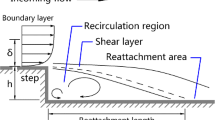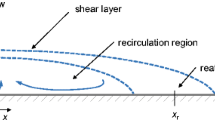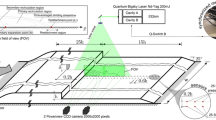Abstract
The laminar and turbulent flow over a backward-facing step placed in a square duct was investigated numerically. The aspect ratio of the step (step width/step height) was 3 and the area expansion ratio was 2∶3. Three-dimensional effects were significant due to the small aspect ratio. To simulate turbulent flows, both a standardk-ɛ model and a non-lineark-ɛ model were employed and the results were compared. The non-linear model was found to yield better results. From the numerical results, the existence of the corner vortex and the flow field associated with it were clarified. The reattachment length of the three-dimensional flow was found to be considerably shorter than the corresponding two-dimensional flow. The evolution of longitudinal vortices was visualized. Surface flow patterns which clearly demonstrate three-dimensional aspects of the flow were presented. Based on various data available, topological flow pattern was also sketched. To support the findings explored in the present work, expeirmental data were compared with the numerical data where applicable.
Similar content being viewed by others
Abbreviations
- AE,AW,AN,AS,AT,AB:
-
Finite-difference coefficients
- C1,C2,Cμ,CD,CE:
-
Turbulence model constants
- G :
-
Production rate ofk
- h :
-
Step height
- k :
-
Turbulent kinetic energy
- P :
-
Static pressure
- Re :
-
Reynolds number based on step\(height\left( { = \frac{{Uoh}}{v}} \right)\)
- S ϕ :
-
Integrated source term in finite difference equation
- U, V, W :
-
Local velocity in each direction
- \(\overrightarrow U \) :
-
Velocity vector
- Uo :
-
Reference velocity in the plane of the step edge
- \(\bar u',\bar v'\) :
-
r.m.s. value of velocity fluctuations
- x, y, z :
-
Longitudinal, Transverse, Spanwise Coordinates
- x r :
-
Reattachment length
- Λ:
-
Diffusion coefficient
- ε:
-
Dissipation rate ofk
- μ:
-
Molecular viscosity
- μt :
-
Turbulent viscosity
- σk, σɛ :
-
Turbulence model constants
- ϕ:
-
Scalar quantity
- ρ:
-
Fluid density
- τij :
-
Reynolds stress tensor
- τiq :
-
Wall shear stress
- F :
-
Foci at the surface
- N :
-
Nodal point
- S :
-
Saddle point
References
Amano, R.S., 1984, “Development of a Turbulence Near-Wall Model and its Application to Separated and Reattached Flows,” Numerical Heat Transfer, Vol. 7, pp. 59–75.
Armaly, B.G., Durst, F., Pereira, J.C.F. and Schonung, B., 1983, “Experimental and Theoretical Investigation of Backward-Facing Step Flow,” J. Fluid Mech., Vol. 127, pp. 473–496.
Bradshaw, P., 1987, “Turbulent Secondary Flows,” Ann. Rev. Fluid Mech., Vol. 19, pp. 53–74.
Chen, Y.S., 1986, “A Computer Code for Three-Dimensional Incompressible Flows Using Nonorthogonal Body-Fitted Coordinate Systems,” NASACR-178818.
de Brederode, V. and Bradshaw, P., 1972, “Three-Dimensional Flow in Normally Two-Dimensional Separation Bubbles: I. Flow Behind a Rearward-Facing Step,” Aeronautical Report, No. 72-19, Imperial College.
Demuren, A.O. and Rodi, W., 1984, “Calculation of Turbulence-Driven Secondary Motion in Non-Circular Ducts,” J. Fluid Mech., Vol. 140, pp. 189–222.
Denham, M.K. and Patrick, M.A., 1974, “Laminar Flow Over a Downstream Facing Step in a Two-Dimensional Flow Channel,” Trans. Inst. Chem. Engrs., Vol. 52, pp. 361–367.
Di Prima, R.C. and Stuart, J.T., 1983, “Hydrodynamic Stability,” J. Applied Mechanics, Vol. 50, pp. 983–991.
Durst, F. and Rastogi, A.K., 1979, “Theoretical and Experimental Investigations of Turbulent Flows with Separation,” in “Turbulent Shear Flow,” Durst, F., Launder, B.E. and Schmidt, F.W., Eds., Springer-Verlag, Newyork, Vol. 1, pp. 208–219.
Eaton, J.K., 1980, “Turbulent Flow Reattachment: An Experimental Study on the Flow and Structure behind a Backward-Facing Step,” Ph.D Thesis, Stanford University.
Eaton, J.K. and Johnston, J.P., 1981, “A Review of Research on Subsonic Turbulent Flow Reattachment,” AIAA. J., Vol. 19, pp.1099–1100.
Gessner, F. B., 1982., “Corner Flow (Secondary Flow of the Second Kind),” The 1980–1981 AFOSR-HTTM-stanford Conference on Complex Turbulent Flows, Stanford University, Vol. I., pp. 182–212.
Goldstein, R.J., Ericksen, V.L., Olson, R.M., and Eckert, E.R.G., 1970, “Laminar Separation, Reattachment and Transition of the Flow over a Downstream-Facing Step,” Trans. ASME, J. of Basic Eng., Vol. 92, pp. 732–741.
Hackman, L.P., Raithby, G.D. and Strong, A.B., 1984, “Numerical Predictions of Flows Over Backward-Facing Steps,” Int. J. Numer. Methods in Fluids, Vol. 4, pp. 711–724.
Humphrey, J.A.C., Whitelaw, J.H. and Yee, G., 1981, “Turbulent Flow in a Square Duct with Strong Curvature,” J. Fluid Mech., Vol. 103, pp. 443–463.
Kao, H.C., Burstadt, P.L. and Johns, A.L., 1983, “Flow Visualization and Interpretation of Visualization Data for Deflected Thrust V/STOL Nozzles,” NASA TM 83554.
Kim, J.J., 1987, “Investigation of Separation and Reattachment of a Turbulent Shear Layer: Flow Over a Backward Facing Step,” Ph. D Thesis, Stanford University.
Launder, B.E. and Spalding, D.B., 1974, “The Numerical Calculation of Turbulent Flows,” Comput. Methods in Applied Mech. and Engr., Vol. 3, pp. 269–289.
Lim, K.S., Park, S.O. and Shim, H.S., 1990, “A Low Aspect Ratio Backward-Facing Step Flow,” Experimental Thermal and Fluid Science, Vol. 3, pp. 508–514.
Nallasamy, M., 1985, “Critical Evaluation of Various Turbulence Models as Applied to Internal Fluid Flows,” NASA TP 2474.
Patankar, S.V., 1980, Numerical Heat Transfer and Fluid Flow, McGraw-Hill
Qin, H., 1984, “Flow Characteristic of a Sudden Axisymmetric Expansion,” PDR/CPDUIC/4, Imperial College of Science and Technology, London.
Rodi, W. et al., 1982, “The 1980–1981 AFOSR-HTTM-Stanford Conference on Complex Turbulent Flows,” Stanford University, Vol. III, pp. 1495–1516.
Ruderich, R. and Fernholz, H.H., 1986, “An Experimental Investigation of a Turbulent Shear Flow with Separation, Reverse Flow, Reattachment,” J. Fluid Mech., Vol. 163, pp. 283–322.
Spalding, D.B., 1972, “A Novel Finite Difference Formulation for Differential Expressions Involving both First and Second Derivatives,” Int. J. Numer. Methods Engr. Vol. 4, pp. 551–556.
Speziale, C.G., 1987, “On Nonlinerk-1 andk-ɛ Models of Turbulence,” J. Fluid Mech., Vol. 178, pp. 459–475.
Stevenson, W.H., Thompson, H.D. and Craig, R.R., 1984, “Laser Velocimeter Measurements in Highly Turbulent Recirculating Flows,” Trans. ASME. J. of Fluids Eng., Vol. 106, pp. 173–180.
Van Doormaal, J.P. and Raithby, G.D., 1984, “Enhancements of the Method for Predicting Incompressible Flows,” Numerical Heat Transfer, Vol. 7, pp.147–163.
White, F.M., 1974, “Viscous Fluid Flow,” McGraw-Hill, pp. 123–125.
Author information
Authors and Affiliations
Rights and permissions
About this article
Cite this article
Park, S.O., Lim, K.S. & Pletcher, R.H. A numerical study of three-dimensional backward-facing step flow. KSME Journal 7, 1–13 (1993). https://doi.org/10.1007/BF02953140
Received:
Issue Date:
DOI: https://doi.org/10.1007/BF02953140




